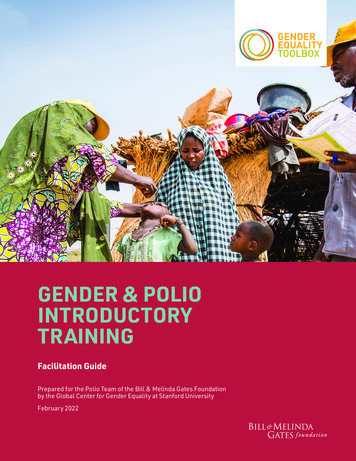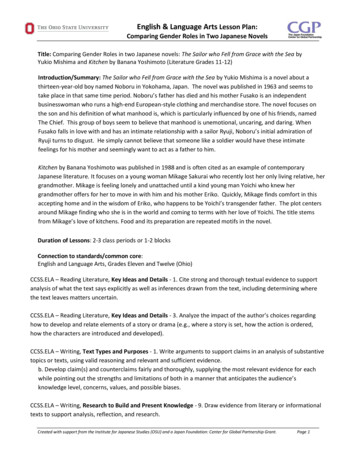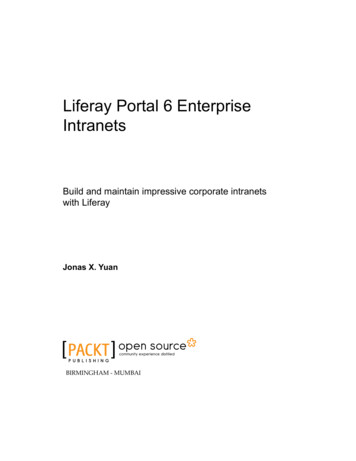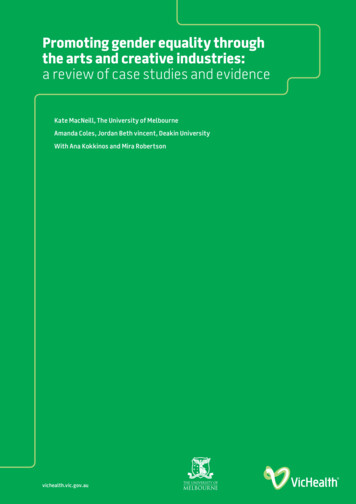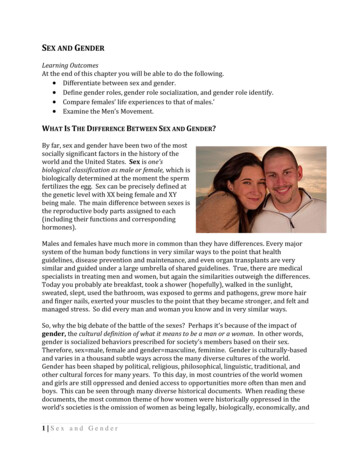
Transcription
Promoting Positive Gender Roles inMarketing and AdvertisingINTERIMINTERIMRECOMMENDATIONS,27 27MARCHMARCH2020IntheRECOMMENDATIONS,Contextof COVID-19:Key2020Considerationsfor BusinessThisThisdocumentdocumentbuildsbuildson materialon materialdevelopeddevelopedby UNICEFby UNICEFEAPRO,EAPRO,UNICEFUNICEFESAROESAROand andthe ILO.the ILO.It is Itanisinteriman din a infast-evolvinga fast-evolvingsituation.situation.It providesIt nsthatthataim aimto helpto upportfor workersfor workersand andtheirtheirfamilies.families.It needsIt needsto betoadaptedbe adaptedlocallylocallyand andto rapidlyto rapidlychangingchangingcontexts.contexts.As theAs informationthe informationcontainedcontainedin inthis you youare advisedare advisedto checkto checkthe sourcesthe sourcesand andonlineonlineinformationinformation(via (vialinks)links)regularly.regularly.
Promoting Positive Gender Rolesin Marketing and AdvertisingIn the Context of COVID-19: Key Considerations for BusinessApril 2020This document builds on material developed by UNICEF Programme Division, Gender, UNICEF Regional Office for South Asia, UNICEF PrivateFundraising and Partnerships, and UN Women. It benefited from the contributions of multiple colleagues; writing was provided by Emer O’Doherty;editing was provided by Catherine Rutgers. We emphasize that this is an interim guidance note, developed in a rapidly evolving situation. It shouldnot be seen as promoting particular work arrangements or other measures. Rather, it provides recommendations to business in relation to thesocial and economic crisis created by COVID-19. Some content may date quickly, and you are advised to check the sources and online information(via links) regularly.Cover photo credits: UN Women/Ryan Brown, UNICEF/UNI317535 Frank Dejongh, Getty ImagesThe views expressed in this publication do not necessarily represent the views of UNICEF and UN Women, and UNICEF and UN Women make no representationconcerning the source, originality, accuracy, completeness or reliability of any statement, information, data, finding, interpretation, advice or opinion contained herein. United Nations Children’s Fund (UNICEF) 2020
IntroductionIn an effort to address the impacts of COVID-19, companies are making anumber of socially beneficial communications to the public. It is essentialthat these communications avoid harmful stereotypes and seek to depictpositive and progressive gender portrayals. This document providesconsiderations for corporate entities currently creating socially beneficialcommunications.The unprecedented consequences of the coronavirusdisease (COVID-19) outbreak are being felt aroundthe world. Beyond the immediate public healthrisks of COVID-19, many women, children and theirfamilies are caught in a fast-evolving situation thathas disrupted education and childcare, threatenedprotection from or treatment of all types of illnesses,and led to immediate or impending loss of householdincome. Restrictions on movement and the socioeconomic fallout of the crisis put women and childrenat heightened risk of abuse, neglect and violence.1Moreover, access to vital sexual and reproductivehealth and other health-care services is in jeopardy,while risks of domestic violence are increasing,along with the likelihood of child marriage andearly pregnancy.The COVID-19 outbreak is heavily affecting the labourmarket and the economy, including global supplychains, leading to widespread business disruptions.Loss of jobs and income, and rising poverty, are rapidlybecoming a reality for many more workers.2 Theabsence of adequate social protection systems furtherexacerbates the vulnerability of working families, andespecially women, who make up a disproportionatepercentage of the informal labour force.For families at the front line of the response, thereis heightened risk of exposure to illness, pressure oflonger work hours, stress and mental trauma, whichall have implications for children and other familymembers. In the health and social sectors worldwide,women constitute 70 per cent of workers, are lesslikely than men to have full-time employment, and facea significant gender pay gap.3In the context of school and childcare closures, thedomestic care responsibilities of parents workingoutside the home, especially women, have increasedconsiderably. Globally, women already do three timesas much unpaid care work as men. Experiences fromother disease outbreaks, such as the Ebola virusdisease and the Zika virus infection, show that thisburden of care also increases women’s risk of infection.This makes for a challenging time to engage audienceswith messages of service and support. While manybrands are currently struggling to produce newmarketing materials in response to the health crisis,others are taking the time to assess their messagingand ensure it reflects COVID-19 sensitivitiesaround impacts such as social distancing andhygiene practices.UNICEF and UN Women do not advocate using thetopic of COVID-19 as a marketing opportunity; however,it is unavoidable that some media and brands ororganizations will be particularly motivated to respond.1 See, for example: UNICEF, ‘COVID-19: Children at heightened risk of abuse, neglect, exploitation and violence amidst intensifying containment measures’, 20 March 2020.2 Initial estimates by the International Labour Organization “point to a significant rise in unemployment and underemployment in the wake of the virus, all figures indicate a substantial rise inglobal unemployment.” (ILO, ‘COVID-19 and the World of Work: Impact and policy responses’, 18 March 2020, p. 3).3 Boniol, Mathieu, et al., ‘Gender Equity in the Health Workforce: Analysis of 104 countries’, Working Paper 1, World Health Organization, Geneva, March 2019, p. 1.PROMOTING POSITIVE GENDER ROLES IN MARKETING AND ADVERTISING IN THE CONTEXT OF COVID-193
Businesses may be communicating to customersor employees about protection against COVID-19,highlighting helpful products or services, reflecting thereality of changed lives or communicating initiativesfor social good.During this time of global crisis, we have acrucial opportunity to inspire everyone towork together in the ongoing enterpriseof promoting positive gender roles toeveryone’s benefit.Marketing communications have always had a uniqueplatform for portraying empowering gender roles,allowing girls’ and women’s voices to be heard andrepresenting their needs as well as those of boys andmen. In all types of public or internal communication,it is also important to recognize that unconscious biascan lead to unintended use of harmful stereotypes,especially in such a fast-moving situation.When we depict positive gender roles, taking careto include female perspectives and avoid harmfulstereotypes around women’s and girls’ roles insociety, media and marketing and advertising, wecan play a proactive role in challenging social normsand discrimination and balancing the burden of carecurrently experienced in homes around the world.Emergencies can offer opportunities for heightenedawareness around positive change and promote theimportance of women’s voices and leadership. Thecurrent situation provides a chance to disrupt genderstereotypes, change traditional narratives, and showthat leadership and decision-making, household chores,and caring for and teaching children can and should beshared responsibilities, advancing equality for all.Considerations to Ensure Gender Equality andPositive Representation Through Marketingand AdvertisingMarketing communications during the COVID-19 crisis can act as a positiveforce in driving gender equality for the benefit of all. To avoid harmful genderstereotypes that can increase the burden on women and girls, considerapplying the 3Ps – Presence, Perspective and Personality: 4PRESENCEPERSPECTIVEPERSONALITYPresence considers who is featuredin the communication. Ensure thata diversity of people – includinggirls and boys, women and men– are included to reflect the worldin which we live.Perspective relates to the framingof the communication, and fromwhose perspective the story is told.Take care to feature female and maleperspectives, equally.Personality refers to the depthof the character. Portray men andwomen, children and young peopleas multidimensional, with their owndepth of personality and agency.4 The 3Ps were developed by the Unstereotype Alliance, UN Women’s action platform that seeks to eradicate harmful gender-based stereotypes in all advertising and media TING POSITIVE GENDER ROLES IN MARKETING AND ADVERTISING IN THE CONTEXT OF COVID-194
DEPICTING WORKPRACTICESAs business puts in place steps to protect workers’ risk of exposure and manyemployees work from home for the first time, consider showing the diversity ofemployees, workplaces and household types as well as the availability and use oftechnology and practical solutions around the world. For example, marketing andadvertising communications could look to: Include women and men at work in a variety of situationsand leadership roles. Reflect the reality of diverse family settings and workingpractices, including multi-generation households, singlemother- or father-led families, and other non-nuclearfamily set-ups. Show teleworking situations to reflect shared solutions indiverse households (couples and other male and femalefamily members sharing space, house-share/roommatesituations, etc.).Include all genders and diverse settings in content givingadvice on how to socially distance, implement safe waysof commuting or receive deliveries into the home. When illustrating health-care settings, reflect the realitythat 70 per cent of health and social sector workersworldwide are women, and show women as doctors anddecision makers, not only nurses, cleaners or caterers. Show how technological solutions in a family contextallow all members of a household to work effectively,and show women using technology as much as men. Depict women in non-traditional work roles (e.g., womenmigrating back to the village after a factory shutdownor leaving a technology company that is closingfor a few weeks). Include all genders in images and content,showing the diversity of society across race, class,ability and body size.DEPICTING EDUCATIONAT HOMEAs more countries take measures to limit the movement of citizensto protect health, there will be an increased need for educationalresources and tools for teaching children at home. To promotepositive portrayals of gender roles, consider if content could: Show both men and women helping children of all agesin home-schooling situations, not just mothers. Portray girls as well as boys being given time, spaceand resources to continue with home-studies whenschools are closed. Show girls and boys in non-stereotypical home-learningactivities (e.g., girls can pursue activities related toscience, technology, engineering and mathematics, whileboys can also practise arts or languages). Show men as well as women demonstrating correctmethods of handwashing to children.Look to ensure that suitable home-schooling resourcessuch as learning materials, books, toys and games areavailable and accessible for both boys and girls. Take careto avoid conveying harmful stereotypes.PROMOTING POSITIVE GENDER ROLES IN MARKETING AND ADVERTISING IN THE CONTEXT OF COVID-195
DEPICTING HOUSEHOLDTASKS AND BURDEN OF CAREWith normal shopping habits suspended and familiesrestricted to their homes, communications might showhow all family members can contribute to householdtasks and caregiving responsibilities. For example: Emphasize equal sharing of all types of work and offermessaging that encourages shared responsibilities andpromotes equal opportunities within the household. Ensure boys and men are also shown preparing meals,doing housework, taking care of children in the homeor bringing children to health centres or hospitals;show boys and men using cleaning products in acompetent manner. Show men and boys caring for young children, the sickand the elderly, as well as women and girls. Consider using marketing and advertising channels topromote messages to end violence within householdsagainst women and children. Make sure household tasks traditionally associatedwith women are portrayed with equal importance astraditional male tasks. Use communications to promotethe idea that traditionally ‘female tasks’ should also becarried out by men and boys, and that women and girlscan do traditionally ‘male’ tasks.Show fathers as well as mothers demonstrating correctmethods of handwashing and preparing healthy meals.Make sure not to reinforce the misconception that familyhygiene is the sole responsibility of mothers or otherfemale family members.COMMUNICATING OPTIONSFOR HOME EXERCISE ANDPERSONAL HEALTHWith movement outdoors restricted, considerharmful stereotypes around the way keepinghealthy in the home is presented. For example,content could look to: Show both girls and boys, women and men exercisingat home and show both mothers and fathers, and otherfemale and male caregivers engaging in exercise (with orwithout children). Avoid gender stereotyping the kinds of sports in whichboys/men and girls/women are participating, and keepan equal balance in portraying girls’ and boys’ skills andcapacities in practising sports. Avoid messages that encourage women and girls touse quarantine as a time to lose weight or achievebeauty standards. In communication portraying and/or encouraging childrenand parents to talk about emotions or the psychologicalburdens of the pandemic, show children and parents,especially boys and fathers, to be experiencingand expressing all spectrums of emotion, includingsadness and grief.PROMOTING POSITIVE GENDER ROLES IN MARKETING AND ADVERTISING IN THE CONTEXT OF COVID-196
Act for Gender EqualityBeyond MarketingBusinesses also have a vital role in taking action to support empowering gender normsbeyond marketing, advertising and other communications. During the COVID-19 crisis, it isincreasingly important for the private sector to protect the most vulnerable groups. The sevenWomen’s Empowerment Principles5, for example, offer a vigorous framework for business inunderstanding and applying concrete measures to promote gender equality.The points outlined below provide ideas for action that support positive gender norms in the workplace,marketplace and community.WorkplaceEnsure that all companies adopt and implementworkplace policies that are gender-sensitive andinclusive of new COVID-19 challenges, e.g., how toensure safety, and deliver training and professionaldevelopment. Such action could aim to: Adopt flexible working arrangements with full payduring the COVID-19 crisis, particularly for parentsand other caregivers, including both men andwomen, and demonstrating their important roleswithin families. Support employees who are unexpectedly workingfrom home through online guidance and trainingon remote working arrangements, processesand technology. Consider providing hazard pay to workers in theservice industry (a majority of whom are women)to cover, at minimum, medical insurance. Set up easily accessible hotline services foremployees that provide resources and guidancefor preventing domestic abuse and violence,and to report risk or instances in the home orother settings.MarketplaceStep up as a responsible business to helpcontain COVID-19 and make us safer, strongerand more connected through inclusive andresponsive supply chain policies and standards ofengagement. For example: Ensure diversity in supply chains, including bysupporting women-owned suppliers and makingthem more visible through pro bono ads. Take the opportunity to discover new localbusinesses, particularly women-ownedcompanies, and support them by sourcing theirproducts and services. Support local retailers to leverage connectivity andmobile services to sell their products. Connect small- and women-owned businesseswith grants and funding opportunities.CommunityIn times of crisis, such as COVID-19, there are manyways for businesses to support their customers andthe broader community. In just a short list of examples,companies can: Contribute targeted financial products and servicesthat help women and girls overcome specificCOVID-19 challenges. Donate personal protective equipment,food and services. Consider supporting employees’ householdcosts for rent and utilities (water, gas, electricity,internet access).5 The Women’s Empowerment Principles (WEPs) are based on international labour and human rights standards, and grounded in the recognition that businesses have a stake in and aresponsibility for gender equality and women’s empowerment. For more information and associated resources, see: https://www.weps.org/about. This work is funded by the European Unionthrough the WE EMPOWER G7 programme (2018-2020).PROMOTING POSITIVE GENDER ROLES IN MARKETING AND ADVERTISING IN THE CONTEXT OF COVID-197
4 The 3Ps were developed by the Unstereotype Alliance, UN Women's action platform that seeks to eradicate harmful gender-based stereotypes in all advertising and media content, https://www.unstereotypealliance.org. PROMOTING POSITIVE GENDER ROLES IN MARKETING AND ADVERTISING IN THE CONTEXT OF COVID-19 4



